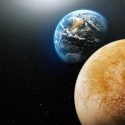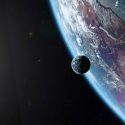Our Universe was born billions of years ago. And since that time, it’s given birth to millions of galaxies, our Solar System, and who knows what else. Our Universe has been evolving for 13.8 billion years, but how exactly did we get here? Well, strap in! Because today, we’re going back in time to explore the history of the Universe in 10 minutes.
13.8 BILLION YEARS AGO
In the beginning, there was nothing. Then suddenly, the Big Bang happened and created our Universe. OK, maybe it’s a little more complicated than that. How this cosmic event began is largely a mystery. But once it got started, it’s never stopped. Within milliseconds, particles like quarks and photons are formed. They’re just some of the building blocks that make up the world you know today.
A couple of minutes later, more elements were born. Protons and neutrons combine to create elements like helium and deuterium. And for the next 400 million years, the Universe will continue to rapidly expand.
13.4 BILLION YEARS AGO
After hundreds of millions of years of chaos and rapid expansion, things will slow down a bit. This will begin the formation of the first structures of our Universe. Think of these structures as the ingredients that make up our stars, galaxies, and even planets like Earth.
Next, we see the formation of primordial gas clouds made up of helium and hydrogen – two of the elements that were created earlier. These gas clouds have been pulled together over millions of years through the force of gravity.
Once they came together, over millions of more years, they slowly got denser and denser. But let’s speed this up.
13 BILLION YEARS AGO
As our gas clouds are getting closer and denser, they’re also getting hotter. Once the center of one of these clouds reaches 10 million degrees Kelvin, it’ll suddenly ignite, creating a process known as nuclear fusion. The hydrogen atoms will combine to form helium, releasing an incredible amount of energy. Suddenly, the first star in our Universe is born.
But this isn’t the only one. Within these cosmic clouds, billions of stars are now being created. And these aren’t just shiny balls of light. They’re going to play an integral part in shaping our Universe. And not all these stars are identical. As they’re born, they’ll form in different shapes and sizes. Some will be massive blue giants, while others will be smaller red dwarfs. It’s not just their size that’s different.
Stars have different lifespans, too. Some live for tens of millions of years, while others live for trillions. And as we’ve been observing these stars, something fascinating has been happening. These stars don’t like to chill in space by themselves. They want to group together. And it just so happens that when these stars, along with other particles like gas, dark matter, and dust, group together due to gravitational forces, they form galaxies.
Galaxies like the Milky Way and Andromeda were formed in this way. But that won’t be for a couple more billion years.
12.5 BILLION YEARS AGO
Over hundreds of millions of years, the Universe continued to expand. More galaxies formed, and they began to evolve in fascinating ways. In a common theme we’ve been seeing throughout our travels, the galaxies started to gravitate toward each other. Gravity is pretty important, huh?
As these galaxies begin to pull together, they create galaxy clusters. These are the largest gravitational structures we know of. At this time, we’re also seeing some of the stars that formed near the beginning of the Universe starting to die out. They’re exploding into supernovas. But don’t be sad that they’re dying. These supernovas are a necessary sacrifice to provide the Universe with essential elements that will later create planets and life.
Speaking of essential elements, I should also mention dark matter. This mysterious substance doesn’t emit or absorb any light and plays a pivotal role in the tapestry of the Universe. Even though we can’t see dark matter, we know that it has a strong pull that has helped shape everything up until now. Dark matter is like a hidden framework that’s helped form our galaxy clusters and other elements of the Universe.
9 BILLION YEARS AGO
Now is where things get more familiar. After several smaller galaxies come together, the Milky Way begins to form. Our sister galaxy, the Andromeda galaxy, was also created during this time. And in other similar galaxies, solar systems are starting to be created. Enormous clouds of gas and dust collapse under their own gravity, bonding together and creating early planets and solar systems. And it only gets more interesting from here.
4.6 BILLION YEARS AGO
OK, we’ve been away for a couple billion years, and during that time, the Universe has continued to expand. More solar systems and galaxies have formed, and way more stars have been created. Speaking of stars, arguably the most important star in all of space was born, our Sun. After our Sun is born, extra gas and dust surround it. Over time, these particles clump together, eventually growing larger and larger. This process creates planetesimals – the beginning of the planets we know today in our Solar System.
Over time, these planetesimals grow larger and larger through countless collisions and gravitational attractions. One of these protoplanets that’s emerging is Earth. Its growth is marked by a pivotal event. A Mars-sized body known as Theia crashes into our planetesimal, which creates what we now call Earth and our Moon. Similar collisions of celestial bodies create the other rocky planets we know today. Mercury, Venus and Mars.
Over in the cooler regions of space, further away from the Sun, gas giants like Jupiter and Saturn are forming. Now, checking back in on our rocky planets, they look significantly different than they do in the present day. They’re a lot smoother than I remember. Well, just wait a couple more million years for what’s known as ‘the late heavy bombardment’ to occur.This cosmic event saw massive asteroids hit these rocky planets. That played a huge role in how they’re shaped today.
3.5 BILLION YEARS AGO
After billions and billions of years, we finally start to see life appear in our Universe. But don’t get too excited. These are simple, single-celled organisms known as prokaryotes. They lack many of the essential features for life today but are still an important part of our evolution. You currently have trillions of them living on your body.
Not long after this, oxygen begins to appear on Earth, and so do multi-celled organisms. Earth’s climate is beginning to take shape, we see the introduction of the ozone layer, which protects life from harmful radiation from space.
600 MILLION YEARS AGO
OK, another couple of billion years have passed, and a lot has happened. The organisms that were microscopic have evolved to become creatures with vertebrae. This is a significant milestone and a precursor to all other vertebrate life on Earth, including you. I didn’t choose this vertebrate life. This vertebrate life chose me.
And even more change happens during this time. Plants are evolving, and continents are moving.
200 MILLION YEARS AGO
This is the age of reptiles and Pangea. But it also had its shortcomings. A mass extinction event occurs, wiping out a vast majority of the species that have been so patiently evolving. This sets the stage for dinosaurs and mammals to emerge. As this era comes to a close, Pangea begins to fragment, laying the groundwork for our modern continents.
MODERN-DAY
And now we’re here. In the hundreds of millions of years that have passed, humans have arrived and evolved, modern civilization was born, and now we’re looking to move forward again. Who knows what’s next? Space travel? Climate change? Future technology? I guess we’ll find out when we travel 1 billion years into the future.



























